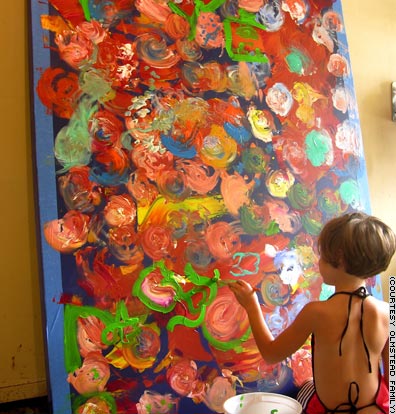Wiki: The Turing test is a test of a machine‘s ability to exhibit intelligent behavior. A human judge engages in a natural language conversation with one human and one machine, each of which tries to appear human. All participants are separated from one another. If the judge cannot reliably tell the machine from the human, the machine is said to have passed the test. In order to test the machine’s intelligence rather than its ability to render words into audio, the conversation is limited to a text-only channel such as a computer keyboard and screen.[2]
Ed. I think art needs a similar test. Read on …
From CBS 60 minutes, Charly Rose,. (excerpted) Marla Olmstead is just like any other child her age. She goes to pre-school, plays with dolls, and loves to draw and has signed her name to dozens of works deemed breathtaking by fans of abstract art. Her paintings are selling as fast as she can finish them — for as much as $24,000.
Before Marla’s second birthday, “She just wanted to paint. She asked me that question. She said, ‘Can I paint, dad, can I paint,'” recalls Marla’s father, Mark, an amateur painter himself. “And I just said, ‘OK.’ You know, good diversionary tactic so I could try to paint.” Her father said i.. he’s hardly ever had to scrap a painting because it’s no good.
… Marla was featured in The New York Times, in an article titled “Portrait of the Artist as a Young Girl.” Time magazine called her a “pint-size Picasso.” And she appeared on NBC, as well as CBS.
Her paintings were even compared to those of Jackson Pollock, the legendary abstract expressionist who was famous for dripping paint freely on his large canvases. Others said her bright colors and shapes reminded them of another modern master, Wassily Kandinsky.
Ellen Winner is a psychologist who has studied gifted children and specializes in visual arts. 60 Minutes Wednesday showed her several of Marla’s works. “It’s beautiful. It’s absolutely beautiful. You could slip it into the Museum of Modern Art,” says Winner. “I think you could fool people. They’re good. They’re good. I have never seen a child prodigy paint in art abstractly. I’ve only seen them paint realistically or representationally. I have a drawing of Picasso at age 9. It shows that Picasso was struggling to draw realistically, and he was way ahead of his age.”
60 Minutes Wednesday taped Marla starting a new work.
Winner was particularly interested in seeing Marla’s creative process in action. 60 Minutes Wednesday showed her more than 50 minutes of videotape shot by CBS, and by Marla’s parents. Winner’s enthusiasm immediately turned to concern and suspicion. “This is eye-opening to me to see her painting,” says Winner. “Because she isn’t doing anything that a normal kid wouldn’t do. She’s just kind of slowly pushing the paint around. I expected to see a child feverishly and intensively working at her canvas and filling up space.”
Winner asked 60 Minutes Wednesday if anyone had ever seen Marla paint a piece from start to finish. The Olmsteads agreed to let 60 Minutes Wednesday place a concealed camera where Marla paints, so she wouldn’t be distracted by its presence. Beginning on a canvas primed red by her father, it took Marla about five hours of painting, spread over the course of a month, to complete a piece.
“My mind was not changed by watching 4-and-a-half hours of home videotape. I saw her making very ordinary kinds of marks, no different from what a typical 3- or 4-year-old would make. She didn’t seem to have any overall plan. And she didn’t seem very focused,” says Winner. “I saw no evidence that she was a child prodigy in painting. I saw a normal, charming adorable child painting, the way preschool children paint, except that she had a coach that kept her going.”
Her coach is her father, Mark, who is often present when Marla paints. He can be heard on the tape, directing her, sometimes sternly:
Marla’s parents told 60 Minutes Wednesday that the painting was a struggle for their daughter, saying she seemed stuck. Still, during the month or so that the hidden camera was in their home, they claim Marla was able to finish four other paintings off camera, with no problems at all.
Winner also believes the painting captured on the 60 Minutes Wednesday tape is less polished than some of Marla’s previous works. How does she explain that difference?
“I can only speculate. I don’t see Marla as having made, or at least completed, the more polished looking paintings, because they look like a completely different painter,” says Winner. “Either somebody else painting them start to finish, or somebody else doctored them up. Or Marla just miraculously paints in a completely different way than we see on her home video.”
And Winner isn’t the only skeptic. 60 Minutes Wednesday spoke with two other specialists in children’s art. While they didn’t study Marla as intensively, they independently raised similar concerns.
“It’s a story that invites skepticism. And there will be skeptics,” says Laura Olmsteads, Marla’s mother. “And, you know, as long as the people who are purchasing the work believe Marla did it, and as long as our friends and family, and the people that matter believe it, that’s enough for me.”
Marla’s paintings end up in homes across the country. She has already earned more than $300,000, which her parents say has all been put into a college fund. With some 200 buyers on her waiting list, Marla stands to make millions. Marla is having her first West Coast gallery opening later this week. It will include the painting captured on hidden camera by 60 Minutes Wednesday, which has already been sold for $9,000.